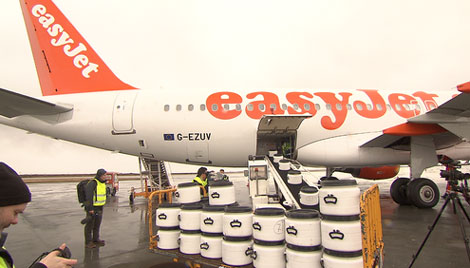Easyjet has announced it has successfully completed the final stage of testing the AVOID (Airborne Volcanic Object Identifier and Detector) system after creating an artificial ash cloud.
The carrier first unveiled plans for the ash cloud radar technology, which uses infrared fitted to aircraft to supply images to pilots and airline flight control centres, in 2010 and has been working on it ever since (see online news, December 2011).
The images will enable pilots to see an ash cloud up to 100km ahead, at altitudes of between 5,000 and 50,000 feet, allowing them to make adjustments to the flight path.

Now Easyjet and its partners Airbus and Nicarnica Aviation have flown an aircraft fitted with the AVOID system through an artificial ash cloud.
The airline used an A400M to disperse one tonne of Icelandic ash into the atmosphere at between 9,000 and 11,000 feet, thereby creating conditions consistent with the eruption of the Eyjafjallajokull volcano that closed British airspace for several days in April 2010.
Easyjet then flew an A340-300 test aircraft fitted with the AVOID technology towards the ash cloud, and successfully identified and measuring it from around 60km away.
The experiment also used a small aircraft, a Diamond DA42 from Dusseldorf University of Applied Sciences, to fly into the ash cloud to take measurements which help to corroborate those taken by the AVOID system.
The ash cloud produced during the test was between 600ft and 800ft deep and measured 2.8km in diameter. To begin with the ash cloud was visible to the naked eye but dissipated quickly, becoming difficult to identify.
The AVOID volcanic sensor detected the ash cloud and measured its density, which ranged from 0.1 to 1 g m-2 – or concentrations of 100 to 1000 µg m-3. This is within the range of concentrations measured during the Eyjafjallajokul ash crisis in 2010.
Ian Davies, Easyjet's engineering director, said: "The threat from Icelandic volcanoes continues and so we are delighted with the outcome of this unique and innovative experiment.
"Finding a solution is as crucial now as ever to ensure we never again see the scenes of spring 2010 when all flying ceased across Europe for several days.
"This is a key step in the final journey of testing the technology and moving towards commercial certification. easyJet will now work towards a non-integrated stand-alone system which we aim to fit onto a number of our current fleet of aircraft by the end of 2014."
Graham Smith








